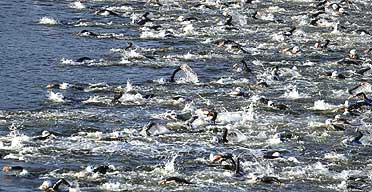
Cardio fitness
Duathlon (run, bike, run) training will get you seriously fit. World Championship distance is 10k, 40k, 5k, but races vary. A 64kg person would burn around 1,850 calories over a standard distance. 5 stars
Training to put three sports together (swim, bike, run) will also send your fitness soaring. In a standard distance race (1500m, 40k, 10k), a 64kg person would burn around 1,800 calories. 5 stars
Upper body
With no swim discipline, there are fewer upper body benefits. However, pumping your arms in running and supporting yourself on the handlebars in cycling, especially off-road, will still tone them up. 3 stars
The swim training will build great strength and definition in the arms, shoulders and back. Swim distances in races range from 400m (super-sprint) to 3,862m (Ironman). 5 stars
Lower body
Training will leave your legs strong and lean. In the second run of the race, your legs must adapt after the earlier run and bike ride, making the lower body challenge more pronounced. 5 stars
While you'll do a bit less running, adding swimming to your training provides low-impact exercise for your joints, while still strengthening your leg and core muscles. 4 stars
Thrill-seekers
There are more off-road duathlons than off-road tris, so they're ideal for mountain biking fans. If you're a sucker for punishment and like winter racing, you can take part in duathlons all year round. 4 stars
Road races are more common. Although training is in full swing, the actual race season runs from May to September because water temperatures are too cold to swim outside all year. 3 stars
Avoiding injury
Training can come with the usual injuries arising from running and cycling, such as strains, sprains and overuse injuries like tendinitis, or back pain from poor cycling posture. 3 stars
The low-impact swim element makes injury slightly less likely. Make sure you have a good swim technique, though, or you can develop shoulder, neck or back pain. 4 stars

